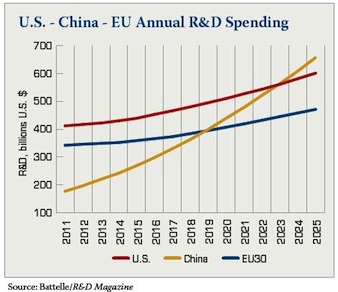It was a ghost who revealed to Ebenezer Scrooge the"shadows of what may be,"but today we rely on studies for similar,if not equally dramatic insights.One such study,released last week,predicts that 2023 may be the year that America loses its global R&D leadership.
Based on current trends,China is on track to overtake the U.S.in spending on research and development in about 10 years,as federal R&D spending either declines or remains flat.

The U.S.today maintains a large lead in R&D spending over China,with federal and private sector investment expected to reach$424 billion next year,a 1.2%increase.
By contrast,China's overall R&D spending is$220 billion next year,an increase of 11.6%over 2012,a rate similar to previous years,according to the 2013 Global R&D Funding Forecast prepared by Battelle,a research and technology development organization,and R&D Magazine."The U.S.still has a significant lead and advantage in R&D over all of these countries,"said Martin Grueber,one of the authors of the report and a lead researcher at Battelle,"but the concern is R&D is a long-term investment,and as these other countries continue to grow their R&D capabilities...how long can we maintain that advantage?"
A major share of R&D research in the U.S.is funded by the federal government,which is expected to budget$129 billion for R&D next year,a decline of 1.4%.This figure could decrease even further if Congress does not resolve its budget impasse.
Government R&D spending is seen as particularly important because,unlike the private sector,it funds basic research.This is research that often takes years or decades to yield results,but it can also lead to new industries and jobs.
Other emerging economies,besides China,are also spending more on R&D.India,for instance,will invest about$45 billion next year in R&D,an increase of just over 12%.
President Obama has called for national R&D expenditures equal to 3%of GDP,which includes private and government investment.The forecast for next year is 2.66%of GDP,according to the Battelle forecast.
The White House also believes that China may overtake the U.S.in R&D spending.
"China's investment as a percentage of its GDP shows continuing,deliberate growth that,if it continues,should surpass the roughly flat United States investment within a decade,"said the President's Council of Advisors on Science and Technology.
R&D is also being hurt by offshoring,which according to the White House report,"has negative long-term consequences for the United States."
The report also said that R&D returns to the U.S.economy are"likely highest when the research is both generated and used within the United States."
Congress appears unlikely to take steps in the near term to improve R&D spending.If anything,there are worries that the so-called fiscal cliff and other budget actions may reduce spending.
Rob Atkinson,president of the Information Technology and Innovation Foundation,said that if sequester happens,it will lead to a cut of 8.8%or$12.5 billion in federally funded research and development funds in 2013 with similar cuts the following years.Similarly,the American Association for the Advancement of Science estimates a budget reduction about as high.
"The fiscal climate right now is just not conducive to growth in federal research investments,"said Peter Harsha,director of government affairs of the Computing Research Association."That's a disturbing trend,especially given the growing research capacity of our global economic competitors.The U.S.leadership role isn't a birthright."





